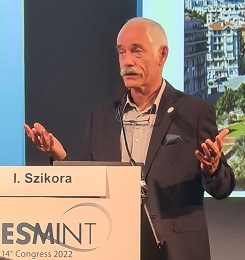
The duration of dual antiplatelet therapy (DAPT), either 30–90 days or more than 90 days, following implantation of a flow diverter in cerebral aneurysm patients has been found to have no significant effect on major complications and adverse events. Lower incidences of reported neurological death or major ischaemic stroke were also observed after the discontinuation of DAPT—regardless of whether a shorter (<90 days) or longer DAPT protocol was used—as per a global analysis presented for the first time at the 2022 European Society of Minimally Invasive Neurological Therapy (ESMINT) congress (7–9 September, Nice, France).
These findings were delivered by István Szikora (National Institute of Mental Health, Neurology and Neurosurgery, Budapest, Hungary) who, speaking to NeuroNews following the session, said: “This study was not designed to compare coated versus non-coated devices, as it only analysed the events [seen with] the Pipeline Shield—the coated version of Pipeline [Medtronic]. The results suggest that elongated DAPT, such as over three months, is likely not needed for the majority of aneurysms. The data presented here may help to design more accurate observational studies to analyse the need for DAPT in association with such devices.”
At the outset of his presentation, Szikora informed the ESMINT audience that DAPT is considered necessary following flow diverter implantation, primarily as a means for preventing thromboembolic complications and reducing in-stent stenosis risks—but there is currently a lack of guidelines regarding the optimal duration for which these treatments should be administered. In addition, studies from the cardiovascular space have highlighted increased bleeding complications, problems with patient compliance and higher costs as potential drawbacks associated with DAPT.
As such, Szikora and his co-investigators set out to analyse the duration of DAPT regimens, within a real-world setting, using three global, postmarket studies of the Pipeline Shield flow diverter: INSPIRE-A, SHIELD OUS and PFLEX. Combining these studies gave the investigators a total population of 750 patients, of which 714 were deemed eligible and had available follow-up data at six months. Szikora detailed that these patients were categorised into different groups based on the length of time for which they received DAPT—with 22 patients receiving DAPT for 0–30 days, 105 patients for 31–90 days (a patient number that Szikora noted was “surprisingly low”) and 605 for >90 days.
“We also had a group of patients who were on DAPT for more than 180 days [containing 353 patients], but this group also included those who were in the third group [>90 days], so there is an overlap between groups three and four,” the speaker added.
Szikora and colleagues analysed all major complications and adverse events across these patient groups—including neurological deaths, major/all ischaemic strokes, thromboembolic complications, significant stenoses and any other major complications. Regarding baseline data, such as age, sex and comorbidities, as well as aneurysm characteristics, no significant differences between the four patient categories were found.
Reporting results from these analyses, Szikora noted a rate of 13% for all major complications/stroke and neurological deaths from 0–30 days, describing this as a high number, but adding that this was a result of three patients dying from bleeding complications within a matter of days following the flow diverter implantation procedure.
“But, comparing [all complications] within 90 days, and after 90 days, we did not find any significant differences,” he continued. “Going further, regarding complication rate by incidence time […], we found that the great majority of the total number of [all thromboembolic complications] occurred within the first 30 days—regardless of how long DAPT was administered for.”
Szikora went on to state that—again, regardless of DAPT duration—a similar preponderance of major bleeding complications, neurological deaths and major/all ischaemic strokes was seen from 0–30 days. He further noted that data on significant stenoses differed slightly, as this is not routinely assessed within the first 30 days post-implantation, but that, based on patients’ first follow-up angiographies, no significant difference was found between the four groups here either.
Detailing the “most significant finding” of this analysis, the speaker reported that—in addition to the vast majority of complications and adverse events occurring within the first 30 days—all but one of these complications/events occurred before the discontinuation of DAPT, with the single event that occurred post-DAPT continuation being seen after more than 350 days in a patient who had received DAPT for over 200 days. He went on to state that, overall, patients who received DAPT for 31–90 days did not have a higher incidence of reported safety events after DAPT discontinuation as compared to those in the longer DAPT duration categories (>90 days and >180 days).
According to Szikora, limitations of this analysis included its retrospective nature, the fact the DAPT duration categories do not precisely reflect those commonly seen in clinical practice (three or six months), the different sample sizes between these categories, and a lack of standardisation due to DAPT regimens being at the treating physician’s discretion—although he claimed the latter was also beneficial in removing the “ethical dilemma” of mandating specific treatment protocols in assessing the significance of DAPT duration.
Briefly touching on future research directions, Szikora noted that these findings highlight the need for prospective studies to assess the impact of DAPT duration on safety outcomes, as this will “help to drive guidelines” in the neurointerventional space. However, responding to a question from session moderator Marios Psychogios (University Hospital Basel, Basel, Switzerland) regarding the timepoint at which patients should be randomised to receive single antiplatelet therapy (SAPT) or DAPT in future studies, Szikora said that, at this point, “we do not have enough scientific evidence to randomise”.
“I believe that these are interesting observations,” he continued, “but we must accept that none of these studies [INSPIRE-A, SHIELD OUS and PFLEX] were designed to answer this question. It would be absolutely irresponsible to start designing a randomised study based on [our analysis]. It is an important piece of information, but we need to continue analysing these data.”
Szikora also reiterated that, in future trials, it would be appropriate to select DAPT timeframes that more accurately reflect everyday clinical practice—for example, three months, as typically prescribed at his own centre—and future analyses may even benefit from excluding patients who receive DAPT for much shorter periods of time—for example, 30 days or less.
In addition, during the same day at ESMINT 2022, Szikora was awarded honorary membership of the society by incoming ESMINT president Zsolt Kulcsár (University Hospital of Zürich, Zürich, Switzerland) for his dedication to the fields of interventional neuroradiology and neurointerventional surgery over the past two decades. Most recently, Szikora played a key role in an initiative using artificial intelligence (AI) and state-of-the-art imaging technologies to improve stroke care and patient outcomes across the Hungarian healthcare system.













